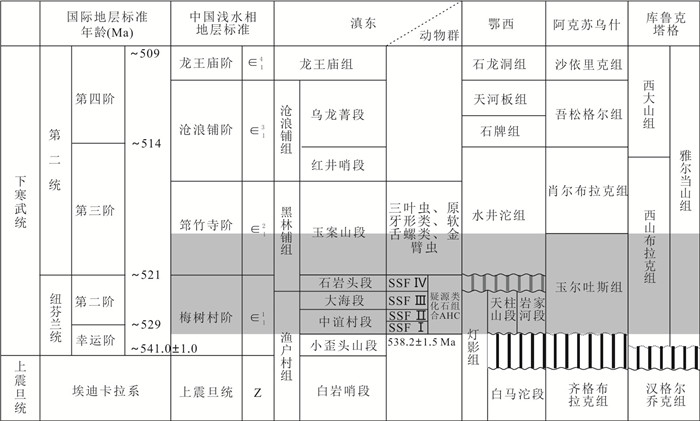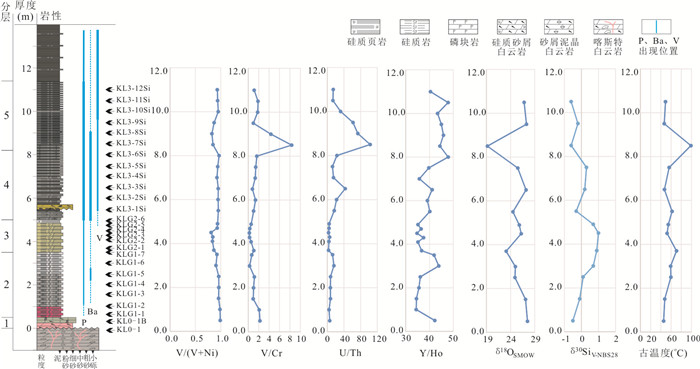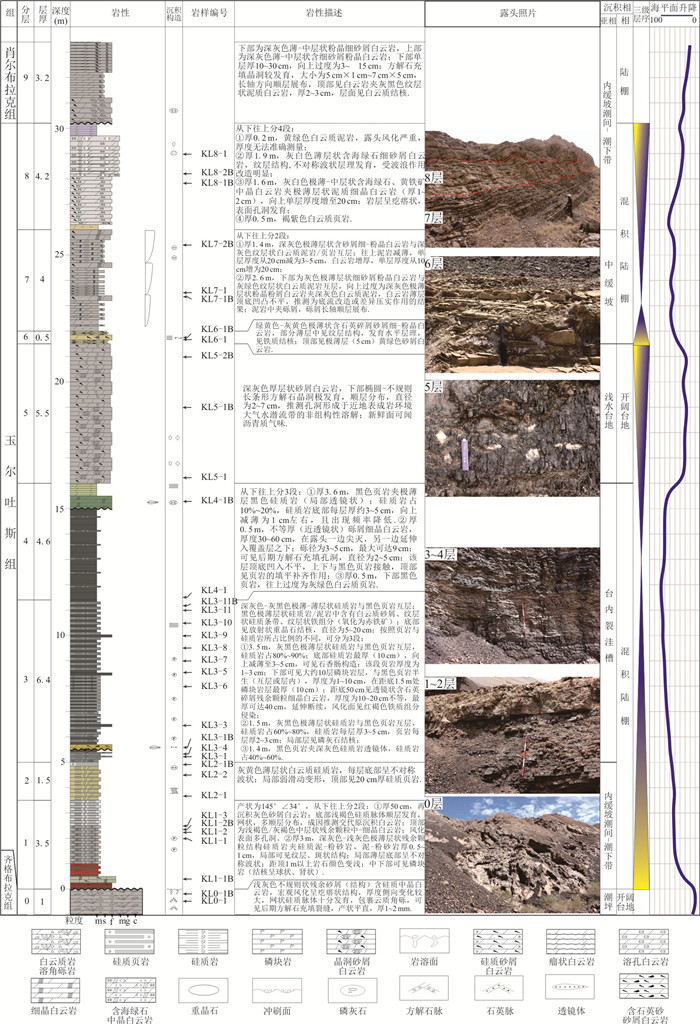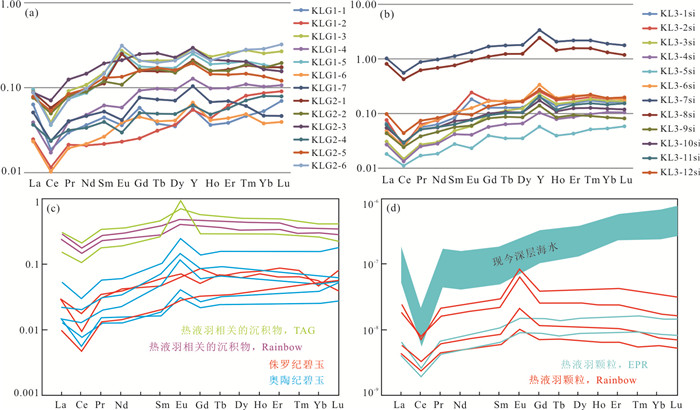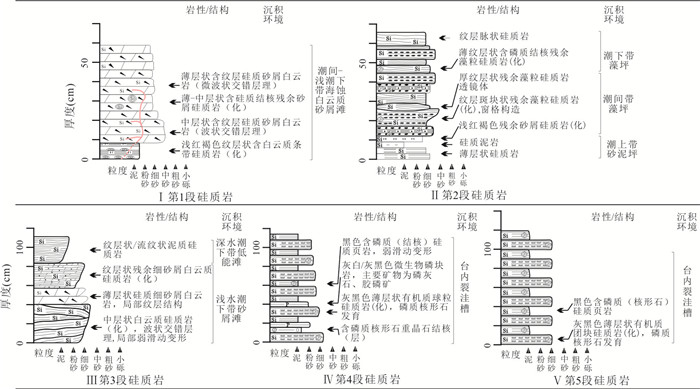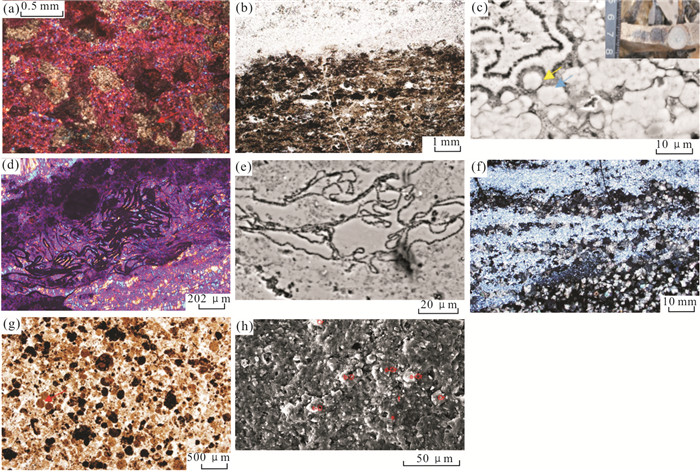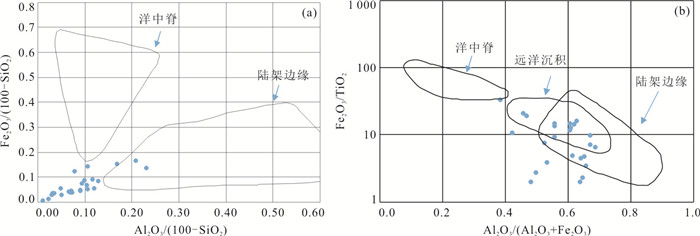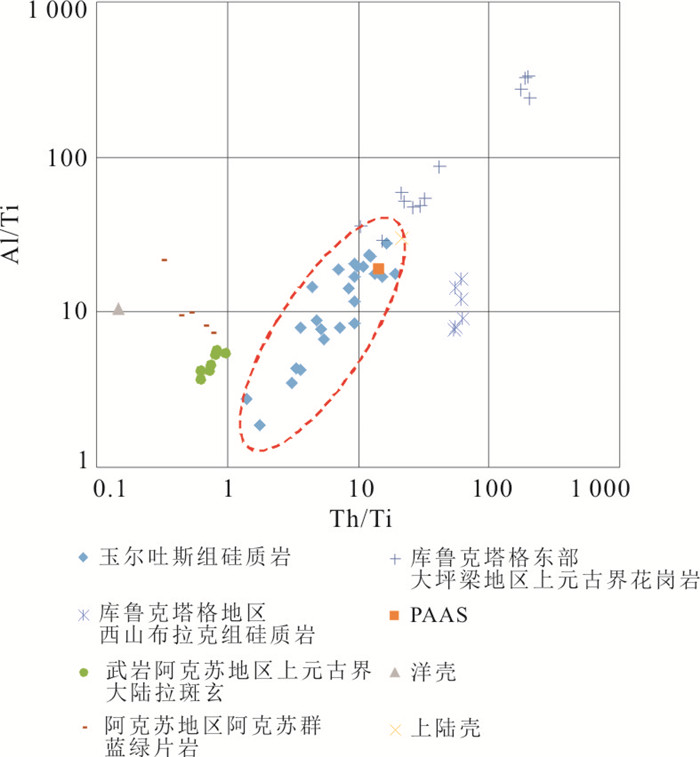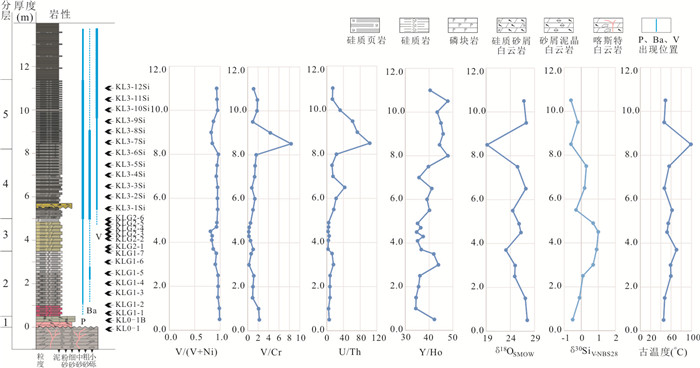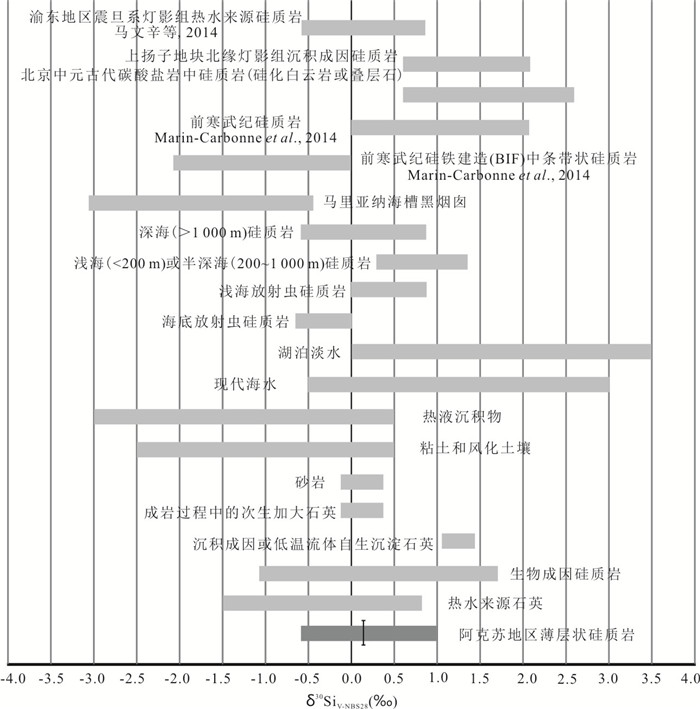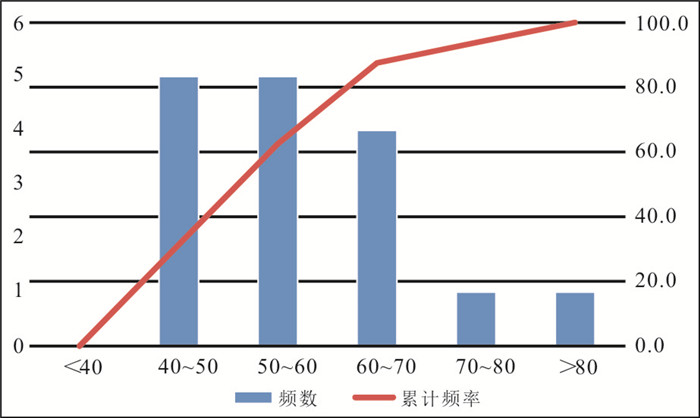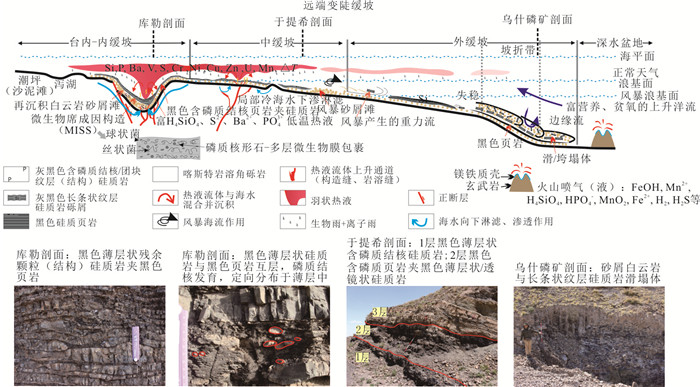Depositional Characteristics of Early Cambrian Hydrothermal Fluid: A Case Study of Siliceous Rocks from Yurtus Formation in Aksu Area of Tarim Basin, Northwest China
-
摘要: 埃迪卡拉纪-寒武纪重要地质历史转折时期全球多陆块广泛沉积硅质岩.塔里木盆地西北缘下寒武统玉尔吐斯组底部所发育的薄层状硅质岩,以富含残余颗粒、磷质结核和重晶石结核而显得非常特殊和罕见,明显有别于国内外报道的常规硅质岩.为了揭示该套硅质岩的成因及沉积模式,通过剖面测量(库勒剖面)、薄片鉴定、SEM观察、能谱探针、主微量元素特征、氧硅同位素分布等岩石学-地球化学分析方法,认为玉尔吐斯组硅质岩垂向上共分5小段,其主要矿物是石英、白云石,自生矿物主要有重晶石、方沸石、黄铁矿等,不同硅质岩段微观结构显示出十分明显的组构变化,包含残余颗粒结构、残余晶粒结构、隐晶质结构和微晶结构.所测剖面硅质岩沉积于靠近大陆/古隆起的高盐度浅海陆架(高Al2O3/(Al2O3+Fe2O3)比值,高MgO/Al2O3比值),其陆源碎屑主要来自大陆地壳或基底花岗岩的风化产物,并且受到SiO2的稀释作用影响(Th/Ti与Al/Ti关系).氧化还原敏感元素(如Ba、V、Ni、Cu、Zn、U等)不同程度的富集及氧化还原指标(V/Cr介于0.81~8.34)特征表明硅质岩段沉积早期处于氧化环境,水体能量较强,显微镜下见圆度较好的内碎屑颗粒、微生物席碎片;中晚期经历了水体循环不畅的有氧/缺氧分层环境(Ce/Ce*负异常),显微镜下微生物球粒、粪球粒、浮游藻(粘结)团块发育,有机质含量较高(TOC可达2%以上).稀土元素特征(低∑REE、中等Ce负异常、显著的Y正异常和Eu正异常)以及δ30Si和δ18O值分布范围暗示硅质岩地球化学特征主要继承自热液流体和海水,受陆源碎屑影响较弱.自近台内裂陷中心上升的富含多金属的富硅热液以及陆源碎屑提供大量营养,为微生物大繁盛和硅质的富集成矿奠定物质基础.水体中硅的溶解度降低(温度降低、pH降低和水体盐度升高)促使硅质胶体颗粒化学沉淀,而微生物(特别是嗜热微生物)的新陈代谢活动往往加速了这一过程.Abstract: Siliceous rocks were widely deposited in many continents during an important geological period, Ediacaran-Cambriam transition. The well developed thin-bedded siliceous rocks in the bottom of Yurtus Formation, northwestern margin of Tarim basin, rich in residual grains, phosphatic nodules and barite concretions, are very special and rare, which is obviously different from conventional siliceous rocks reported at home and abroad. In order to reveal the causes and sedimentary model of this set of siliceous rocks, the advantages of petrological and geochemical methods were used, such as detailed profile measurement (Kule profile), SEM observation, energy spectrum probe, characteristics of main and trace elements, oxygen and silicon isotope distribution. The siliceous rock section can be divided into five units in vertical direction. Its main minerals are quartz and dolomite, and authigenic minerals are mainly pyrite, barite and zeolite; the microstructures of different siliceous rock units show obvious fabric variation, including residual grain structure, residual crystal structure, cryptocrystalline structure and micro-crystal structure. Siliceous rocks of measured profile are deposited in shallow continental shelf near the continental or paleo-uplift with high salinity (high Al2O3/(Al2O3+Fe2O3) ratios, high MgO/Al2O3 ratios), and their terrigenous clastics, affected by the dilution effect of SiO2 (Th/Ti and Al/Ti), are mainly from the weathering products of continental crust or basement granite. Redox sensitive elements (such as Ba, V, Ni, Cu, Zn and U) with different degrees of enrichment and redox indicators (V/Cr ratios from 0.81 to 8.34) indicate that siliceous rocks are developed in the oxidizing environment during early depositional period due to the strong water energy, also supported by many internal clastic particles and microbial mat fragments with good roundness seen under the microscope. And they experienced aerobic/anoxic stratified environment (negative Ce/Ce* anomaly) with limited water circulation during middle to late depositional period, also supported by well-development of microbial pellets, faecal pellets and phytoplankton (bonding) mass seen under the microscope with high organic matter content (TOC up to 2%). Characteristics of rare earth elements (low ∑REE, medium Ce negative anomaly, significant positive Y anomaly and positive Eu anomaly) and distribution range of δ30Si and δ18O values suggest that geochemical characteristics of siliceous rocks have mainly inherited from hydrothermal fluid and seawater, and the terrigenous influence is weak. The polymetallic and Si-rich hydrothermal fluid ascending from rift center near platform and terrigenous clastics provide plenty of nutrition which offers the material foundation for microbial prosperity and the mineralization of SiO2. The decreased solubility of silicon dissolved in water column (due to temperature decreased, the decrease of pH and increase of salinity) promotes the chemical precipitation of silica colloidal particles, and the metabolic activity of microorganisms (especially thermophilic microorganisms) has accelerated this process.
-
Key words:
- Yurtus Formation /
- siliceous rock /
- geochemistry /
- forming cause /
- sedimentary model
-
图 2 塔里木盆地及中国其他地区下寒武统地层对比
据钱逸等(2009); Zhou et al.(2014)修改
Fig. 2. The Lower Cambrian stratigraphic correlation in Tarim basin and other regions of China
图 12 库勒剖面玉尔吐斯组第2、3段硅质岩(a)和第4、5段硅质岩PAAS标准化REE+Y配分模式(b);热液羽相关的富铁氧化物沉积物稀土配分模式(c);现代海洋深层海水和热液羽颗粒物稀土配分模式(d)
c和d引自Zhou et al. (2014)
Fig. 12. The REE+Y patterns normalized to PAAS of the second and third siliceous rock sections (a) and the forth and fifth siliceous rock sections (b) in Yurtus Formation from Kule profile; the REE pattern of iron-rich oxide deposits about hydrothermal plume(c); the REE pattern of modern deep sea water and hydrothermal plume (d)
图 8 玉尔吐斯组底部硅质岩典型薄片特征
a.残余(热液)白云石硅质岩(化),主要矿物由微晶石英、白云石等组成,白云石晶粒不等粒,非平直晶面半自形晶-非平直晶面鞍形晶,波状消光(红色箭头所示),由海蚀砂屑白云岩硅化形成,样号KL0-1B,第1段硅质岩,库勒剖面,正交偏光+石膏试板,比例尺为0.5 mm;b.残余菌藻球粒硅质岩(化),主要矿物由隐晶质硅质、微晶石英、有机质-泥质复合物等组成,薄片上部完全被硅质交代,沉积原始结构完全破坏,薄片下部残余暗色菌藻球粒和碳酸盐岩颗粒(幻影),边界模糊,呈扁椭圆形,长轴顺层分布,样号KL1-1,第2段硅质岩,库勒剖面,单偏光,比例尺为1 mm;c.花边结构磷灰石,宏观上为藻核形石(图右上角所示),由环型毛球藻(Comasphaeridium annulare)(疑源类)(王务严等, 1985; Dong et al., 2009)粘结形成,微生物(藻类)聚磷作用,赋存岩石含磷质结核硅质岩(化),样号KL1-4,第2段硅质岩,库勒剖面,SEM(镀碳),比例尺为10 μm;d.纹层脉状硅质岩(化),主要矿物由玉髓、石英、有机质-泥质复合物等组成,残余藻球粒、藻丝状体(较少),粒度以0.1~0.3 mm为主,最大可达1 mm,多为球状、团块状,少部分不规则状,分选差,混杂堆积,富硅质热液充填脉体顺层展布,呈挠曲纹层状,至少分3期热液充注:第1期脉体较细,宽为30~60 μm,充填柱状微晶石英;第2期脉体变粗,宽为50~200 μm,充填柱状微-细晶石英;第3期最粗,充填细-中晶石英,宽为0.5~1.5 mm,粒状晶粒,镶嵌状分布,样号KL1-6,第2段硅质岩,库勒剖面,正交偏光+石膏试板,比例尺为200 μm;e.硅质岩中丝状体蓝细菌(种属未定),由许多细胞排列粘连而成的群体,单个细胞直径为1~3 μm,该层位大量发育,第2段硅质岩,什艾日克沟剖面,SEM(镀碳),比例尺为20 μm;f.残余白云石硅质岩(化),主要矿物由玉髓、微晶石英、白云石等组成,残余白云石晶粒粒度以0.2~0.4 mm为主,自形-半自形,大部分重结晶,近等粒晶体,见残余再沉积白云质砂屑结构,部分白云石被多期富硅质热液交代,岩石原始结构破坏,残余硅质纹层结构,样号KL2-2,第3段硅质岩,库勒剖面,正交偏光,比例尺为1 mm;g.有机质球粒/团块硅质岩(化),浮游球状甲藻发育(红色箭头所示),球粒粒径大小为200~300 μm,以圆-椭圆形状为主,随着硅质交代程度加深,球粒颜色变浅,色深球粒有机质含量较高,色浅球粒仅残余轮廓,颗粒间被微晶石英、玉髓胶结,样号KL3-7Si,第4~5段硅质岩,库勒剖面,单偏光,比例尺为500 μm;h.黑色硅质页岩,主体为底栖菌藻微生物席,可见片丝状有机质粘结多种粉屑,粉屑主要矿物以有机质(藻类残片)、石英、白云石、黏土矿物(绿/蒙混层、伊/蒙混层)为主,少量钾长石、重晶石、黄铁矿、钛矿,样号HS2-4B,第4~5段硅质岩,于提希剖面,SEM(镀金).代号:D.白云石;Ap.磷灰石;Q.自生石英;Or.钾长石;Ba.重晶石
Fig. 8. Typical thin sections of siliceous rocks in the bottom of Yurtus Formation
图 9 硅质岩Al2O3/(100-SiO2)-Fe2O3/(100-SiO2)协变图(a)和Al2O3/(Al2O3+Fe2O3)-Fe2O3/TiO2协变图(b)
Fig. 9. The covariation of Al2O3/(100-SiO2)-Fe2O3/(100-SiO2) (a) and Al2O3/(Al2O3+Fe2O3)-Fe2O3/TiO2(b) in siliceous rocks
图 10 样品Th/Ti-Al/Ti协变图
库鲁克塔格地区西山布拉克组硅质岩数据据杨瑞东等(2006);阿克苏地区上元古界大陆拉斑玄武岩数据据王飞等(2010);阿克苏地区阿克苏群蓝片岩数据据郑碧海等(2008);库鲁克塔格东部大坪梁地区上元古界花岗岩数据据曹晓峰等(2012)
Fig. 10. The covariation of Th/Ti-Al/Ti in siliceous rocks
图 13 各类型硅质岩δ30Si分布
数据引自Douthitt(1982); Clayton(1986); van den Boorn et al.(2010); 马文辛等(2014)
Fig. 13. δ30Si distribution of cherts of various types
图 14 各类型硅质岩δ18O分布
据Douthitt(1982); Clayton(1986); 陈永权等(2010); 马文辛等(2014)
Fig. 14. δ18O distribution of cherts of various types
表 1 阿克苏地区库勒剖面玉尔吐斯组硅质岩主量元素分析结果(%)
Table 1. Major element compositions (%) of siliceous rocks from Kule profile in Aksu area
样品号 SiO2 Al2O3 TFe2O3 MgO CaO Na2O K2O MnO2 TiO2 P2O5 FeO LOI Total CIA MgO/Al2O3 ∑REE/Fe KLG1C1 91.91 0.28 0.30 0.29 0.54 0.13 0.10 < 0.01 0.15 0.06 0.26 1.26 95.26 0.44 1.06 27.08 KLG1C2 98.50 0.25 0.23 0.06 0.10 0.12 0.09 < 0.02 0.03 0.01 0.19 0.58 100.16 0.44 0.22 22.85 KLG1C3 93.50 0.58 0.32 0.11 0.49 0.34 0.15 < 0.03 0.14 0.30 0.28 1.09 97.29 0.41 0.19 75.86 KLG1C4 97.56 0.28 0.23 0.11 0.54 0.22 0.09 < 0.04 0.02 0.08 0.19 0.86 100.18 0.35 0.37 46.20 KLG1C5 94.69 0.37 0.21 0.11 0.46 0.26 0.10 < 0.05 0.11 0.20 0.18 1.54 98.22 0.37 0.30 101.11 KLG1C6 98.34 0.17 0.24 0.12 0.38 0.10 0.06 < 0.06 0.02 0.05 0.20 0.50 100.18 0.41 0.68 22.46 KLG1C7 97.69 0.17 0.10 0.26 0.73 0.15 0.04 < 0.07 0.02 0.16 0.01 0.65 99.98 0.33 1.59 96.97 KLG2C1 76.11 0.53 0.27 4.59 7.08 0.08 0.08 < 0.08 0.08 0.10 0.21 10.49 99.61 0.69 8.73 78.25 KLG2C2 61.58 0.36 0.20 8.03 11.53 0.08 0.07 < 0.09 0.05 0.09 0.18 17.84 100.01 0.61 22.18 97.24 KLG2C3 87.51 0.62 0.38 2.27 3.77 0.13 0.09 < 0.10 0.03 0.30 0.32 4.89 100.30 0.64 3.69 74.79 KLG2C4 96.64 0.77 0.46 0.27 0.56 0.11 0.15 < 0.11 0.03 0.04 0.30 0.94 100.27 0.68 0.35 16.72 KLG2C5 97.06 0.38 0.25 0.27 0.68 0.10 0.09 < 0.12 0.02 0.20 0.21 0.96 100.20 0.57 0.71 81.74 KLG2C6 91.50 0.84 0.74 0.12 0.16 0.11 0.19 < 0.13 0.19 0.08 0.42 1.59 95.94 0.67 0.14 30.80 KL3C1si 93.09 0.50 0.27 0.14 1.14 0.17 0.13 < 0.14 0.06 0.55 0.21 3.40 99.65 0.52 0.29 59.35 KL3C2si 87.41 0.37 0.37 0.63 2.07 0.20 0.10 < 0.15 0.13 0.81 0.28 3.40 95.78 0.42 1.71 50.88 KL3C3si 98.37 0.34 0.27 0.08 0.15 0.12 0.07 < 0.16 0.02 0.03 0.23 0.54 100.21 0.52 0.23 45.94 KL3C4si 94.16 0.45 0.72 0.13 0.26 0.18 0.14 < 0.17 0.02 0.05 0.49 3.36 99.97 0.47 0.29 10.60 KL3C5si 96.05 0.41 0.27 0.26 0.41 0.12 0.13 < 0.18 0.02 0.03 0.22 2.29 100.19 0.53 0.62 18.14 KL3C6si 94.13 0.39 0.25 0.10 0.16 0.12 0.09 < 0.19 0.02 0.07 0.20 4.64 100.17 0.54 0.26 79.67 KL3C7si 22.47 3.73 4.26 5.52 8.26 0.27 2.39 < 0.20 0.22 0.21 0.97 45.62 93.92 0.56 1.48 59.96 KL3C8si 14.47 2.59 3.06 10.00 14.81 0.14 1.67 < 0.21 0.15 0.32 0.67 45.06 92.94 0.57 3.86 61.14 KL3C9si 96.00 0.48 0.22 0.20 0.19 0.19 0.12 < 0.22 0.03 0.03 0.19 1.99 99.64 0.49 0.42 51.13 KL3C10si 94.38 0.60 0.29 0.12 0.15 0.11 0.21 < 0.23 0.03 0.03 0.25 3.54 99.70 0.58 0.20 47.43 KL3C11si 94.10 0.55 0.43 0.16 0.16 0.12 0.19 < 0.24 0.03 0.03 0.37 4.18 100.32 0.56 0.29 34.82 KL3C12si 93.27 0.60 0.30 0.18 0.18 0.11 0.19 < 0.25 0.04 0.03 0.27 4.53 99.70 0.59 0.29 73.26 注:TFe2O3为全铁含量,LOI为烧失量,CIA=Al2O3/(Al2O3+CaO*+Na2O+K2O),其中CaO*仅为硅酸盐中的CaO,即全岩中的CaO扣除掉化学沉积的CaO的摩尔分数,对于CaO*的计算和校正,McLennan(1989, 2001)提出:CaO*=CaO-(10/3×P2O5),如果CaO* < Na2O,则采用CaO*摩尔分数;反之,则采用Na2O作为CaO*摩尔分数. 表 2 阿克苏地区库勒剖面玉尔吐斯组硅质岩微量元素分析结果(10-6)
Table 2. Trace element compositions (10-6) of siliceous rocks from Kule profile in Aksu area
样品号 Sc V Cr Co Ni Cu Zn Sr Mo Ba Th U Zr V/ (V+Ni) V/ Cr U/ Th Y/ Ho KLG1C1 0.17 696 310.0 5.97 6.3 48.4 60.0 508.0 4.46 15782 0.26 1.50 3.38 0.99 2.25 5.84 42.22 KLG1C2 0.13 543 258.0 0.74 7.8 44.1 61.8 87.2 14.40 2231 0.28 1.18 2.47 0.99 2.10 4.23 34.42 KLG1C3 0.36 280 297.0 0.64 12.1 84.6 51.4 487.0 14.00 13220 0.50 3.77 4.35 0.96 0.94 7.57 34.54 KLG1C4 0.16 188 184.0 0.56 7.4 38.4 28.0 90.5 6.46 2063 0.22 1.64 1.96 0.96 1.02 7.35 35.57 KLG1C5 0.21 232 197.0 0.68 9.3 33.4 39.4 232.0 4.54 10546 0.32 2.54 3.33 0.96 1.18 7.84 36.15 KLG1C6 0.07 57 224.0 1.06 5.9 6.6 15.0 54.9 5.85 2076 0.08 1.26 1.01 0.91 0.25 15.75 43.90 KLG1C7 0.10 60 88.8 0.62 4.8 10.0 18.0 69.4 4.02 1400 0.11 1.39 1.47 0.93 0.67 12.64 41.94 KLG2C1 1.26 80 75.0 1.06 12.4 18.3 29.9 148.0 3.96 6762 0.42 1.23 3.60 0.87 1.07 2.91 36.71 KLG2C2 0.68 60 110.0 0.93 11.6 4.6 23.6 111.0 3.32 4424 0.33 1.20 2.63 0.84 0.54 3.68 35.16 KLG2C3 0.40 47 194.0 0.78 8.7 7.2 33.7 74.7 4.43 1299 0.32 1.78 2.68 0.84 0.24 5.60 37.50 KLG2C4 0.42 42 188.0 2.66 9.8 15.6 29.7 50.5 4.75 777 0.46 1.38 4.24 0.81 0.23 3.02 34.79 KLG2C5 0.30 58 192.0 0.96 4.2 11.8 13.8 91.0 4.13 757 0.40 1.65 3.04 0.93 0.30 4.13 36.50 KLG2C6 0.85 210 371.0 1.12 13.7 52.5 66.3 527.0 14.20 17953 0.64 2.78 7.34 0.94 0.57 4.32 35.17 KL3C1si 0.41 313 304.0 0.80 15.7 211.0 51.9 311.0 3.32 3935 0.27 4.44 3.76 0.95 1.03 16.63 40.15 KL3C2si 0.41 398 286.0 0.95 22.1 181.0 107.0 293.0 8.71 13245 0.19 4.17 2.69 0.95 1.39 22.30 39.14 KL3C3si 0.26 186 231.0 0.87 9.7 41.3 29.9 145.0 9.74 672 0.13 5.49 2.72 0.95 0.81 42.89 41.15 KL3C4si 0.56 387 289.0 1.64 30.8 189.0 142.0 79.8 6.08 370 0.21 3.02 4.34 0.93 1.34 14.73 35.77 KL3C5si 0.39 309 215.0 1.23 19.4 24.9 136.0 37.9 4.80 129 0.21 2.56 3.33 0.94 1.44 12.49 39.74 KL3C6si 0.44 324 197.0 0.61 11.1 45.3 54.1 24.7 5.37 162 0.21 4.82 3.41 0.97 1.64 23.06 47.89 KL3C7si 5.96 976 117.0 27.40 176.0 73.5 1570.0 164.0 169.00 334 3.37 347.00 42.90 0.85 8.34 102.97 44.39 KL3C8si 3.41 307 70.6 24.10 64.5 47.1 204.0 154.0 195.00 169 1.95 143.00 29.10 0.83 4.35 73.33 45.87 KL3C9si 0.30 123 126.0 1.26 18.4 13.1 56.7 57.6 8.49 2117 0.15 9.08 3.41 0.87 0.98 61.77 45.00 KL3C10si 0.62 287 158.0 0.90 14.8 21.2 46.6 46.6 6.38 284 0.33 10.40 7.02 0.95 1.82 31.80 43.43 KL3C11si 0.66 408 218.0 1.49 26.2 44.0 81.6 31.7 5.47 186 0.30 3.99 7.55 0.94 1.87 13.30 47.84 KL3C12si 0.65 252 219.0 1.10 18.0 34.3 48.2 81.2 4.47 1997 0.36 5.02 7.66 0.93 1.15 14.10 40.44 表 3 阿克苏地区库勒剖面玉尔吐斯组硅质岩稀土元素分析结果(10-6)
Table 3. Rare earth element compositions (10-6) of siliceous rocks from Kule profile in Aksu area
样品号 La Ce Pr Nd Sm Eu Gd Tb Dy Y Ho Er Tm Yb Lu oH/Y EER∑ H/L *eC/eC *uE/uE *Y/Y nbY/naL nmS/naL nbY/ndG KLG1-1 2.42 1.49 0.26 1.23 0.25 0.04 0.27 0.03 0.16 1.52 0.04 0.11 0.02 0.15 0.03 42.22 8.0 2.4 0.40 0.85 1.58 1.20 1.42 1.10 KLG1-2 0.94 0.92 0.19 0.71 0.12 0.03 0.12 0.02 0.17 1.48 0.04 0.18 0.03 0.24 0.04 34.42 5.2 1.2 0.50 0.93 1.37 0.29 1.13 0.29 KLG1-3 3.58 3.10 0.81 3.67 0.83 0.29 0.96 0.16 0.99 7.91 0.23 0.73 0.11 0.72 0.12 34.54 24.2 1.0 0.42 1.60 1.33 0.37 0.62 0.81 KLG1-4 1.49 1.37 0.35 1.62 0.34 0.06 0.43 0.08 0.44 3.45 0.10 0.28 0.05 0.29 0.05 35.57 10.4 1.0 0.44 0.79 1.33 0.38 0.63 0.90 KLG1-5 3.66 2.89 0.65 2.94 0.67 0.28 0.83 0.13 0.80 6.76 0.19 0.55 0.08 0.52 0.07 36.15 21.0 1.1 0.43 1.86 1.39 0.52 0.79 0.96 KLG1-6 0.89 0.82 0.17 0.74 0.15 0.04 0.21 0.03 0.19 1.80 0.04 0.13 0.02 0.11 0.02 43.90 5.3 1.1 0.48 1.25 1.62 0.61 0.88 1.19 KLG1-7 1.95 1.88 0.36 1.57 0.29 0.05 0.36 0.06 0.33 2.81 0.07 0.20 0.03 0.13 0.02 41.94 10.1 1.5 0.52 0.71 1.51 1.09 0.98 1.63 KLG2-1 3.38 4.60 0.73 3.23 0.62 0.27 0.73 0.12 0.72 5.69 0.16 0.47 0.08 0.49 0.08 36.71 21.4 1.5 0.67 1.98 1.36 0.51 0.79 0.91 KLG2-2 2.91 3.96 0.70 3.04 0.66 0.12 0.76 0.13 0.70 5.52 0.16 0.45 0.08 0.48 0.08 35.16 19.7 1.4 0.64 0.81 1.32 0.44 0.65 0.95 KLG2-3 3.35 5.64 1.10 4.95 1.07 0.23 1.16 0.20 1.06 7.95 0.21 0.59 0.08 0.46 0.07 37.50 28.1 1.4 0.67 0.99 1.34 0.53 0.45 1.51 KLG2-4 1.40 1.90 0.28 1.14 0.22 0.03 0.24 0.04 0.23 1.67 0.05 0.16 0.03 0.23 0.03 34.79 7.6 1.9 0.70 0.69 1.27 0.46 0.93 0.63 KLG2-5 2.99 4.25 0.74 3.29 0.72 0.15 0.74 0.13 0.75 5.22 0.14 0.41 0.06 0.38 0.05 36.50 20.0 1.5 0.66 0.93 1.27 0.58 0.60 1.17 KLG2-6 3.36 2.96 0.64 3.29 0.81 0.34 0.97 0.15 0.98 7.28 0.21 0.68 0.12 0.81 0.14 35.17 22.7 1.0 0.46 1.92 1.29 0.31 0.60 0.73 KL3-1si 2.53 2.10 0.49 2.14 0.46 0.20 0.59 0.10 0.60 5.46 0.14 0.44 0.07 0.45 0.07 40.15 15.8 1.0 0.43 1.86 1.52 0.41 0.79 0.80 KL3-2si 2.90 2.03 0.56 2.54 0.60 0.26 0.81 0.13 0.77 6.85 0.18 0.52 0.08 0.53 0.08 39.14 18.8 0.9 0.37 1.90 1.49 0.41 0.70 0.93 KL3-3si 1.17 1.17 0.24 1.01 0.27 0.06 0.44 0.09 0.58 6.09 0.15 0.47 0.08 0.48 0.07 41.15 12.4 0.5 0.51 0.84 1.65 0.18 0.63 0.55 KL3-4si 1.03 1.06 0.22 0.95 0.23 0.04 0.27 0.05 0.31 2.79 0.08 0.25 0.04 0.30 0.05 35.77 7.7 0.9 0.51 0.83 1.43 0.26 0.65 0.54 KL3-5si 0.69 0.88 0.15 0.62 0.15 0.03 0.18 0.03 0.16 1.55 0.04 0.12 0.02 0.15 0.03 39.74 4.8 1.1 0.63 0.77 1.54 0.34 0.66 0.74 KL3-6si 1.84 1.97 0.52 2.64 0.58 0.14 0.78 0.13 0.80 9.10 0.19 0.61 0.09 0.54 0.08 47.89 20.0 0.6 0.46 0.99 1.86 0.25 0.46 0.88 KL3-7si 39.00 44.10 7.75 33.00 6.23 1.44 7.84 1.36 8.45 91.00 2.05 6.21 0.89 5.36 0.76 44.39 255.4 1.1 0.58 1.00 1.74 0.54 0.91 0.89 KL3-8si 31.00 33.80 5.48 23.30 4.23 1.01 5.14 0.95 5.81 65.60 1.43 4.47 0.64 3.72 0.51 45.87 187.1 1.1 0.59 1.02 1.81 0.62 1.06 0.84 KL3-9si 1.66 1.92 0.34 1.56 0.31 0.07 0.38 0.07 0.40 3.78 0.08 0.27 0.04 0.24 0.04 45.00 11.1 1.1 0.59 0.91 1.65 0.51 0.77 0.97 KL3-10si 2.09 2.35 0.45 1.88 0.40 0.08 0.47 0.08 0.49 4.69 0.11 0.36 0.05 0.35 0.05 43.43 13.9 1.1 0.56 0.93 1.63 0.45 0.75 0.82 KL3-11si 2.37 2.29 0.45 1.91 0.35 0.08 0.43 0.08 0.49 5.55 0.12 0.41 0.06 0.41 0.07 47.84 15.1 1.0 0.51 1.00 1.85 0.43 0.98 0.64 KL3-12si 3.74 3.48 0.65 2.82 0.56 0.10 0.63 0.12 0.79 7.40 0.18 0.58 0.09 0.54 0.09 40.44 21.8 1.1 0.51 0.80 1.55 0.51 0.98 0.70 注:L/H为LREE/HREE;Ce/Ce*、Eu/Eu*、Pr/Pr*、Y/Y*、La/La*值计算公式( Ling et al., 2013 ):Ce/Ce*=CePAAS/(PrPAAS2+NdPAAS);Eu/Eu*=2EuPAAS/(SmPAAS+GdPAAS);Pr/Pr*=2PrPAAS/(CePAAS+NdPAAS);Y/Y*=2YPAAS/(DyPAAS+HoPAAS);La/La*=LaPAAS/(PrPAAS3/NdPAAS2).Gd/Gd*值计算公式(Bolhar et al., 2004 ):Gd/Gd*=GdPAAS/(2TbPAAS-DyPAAS);后太古宙澳大利亚平均页岩(PAAS)引自Mclennan(1989, 2001).表 5 玉尔吐斯组硅质岩δ30SiNBS⁃28,δ18OV⁃SMOW值及计算温度
Table 5. Contents of δ30SiNBS-28, δ18OSMOW values and calculated temperature of siliceous rocks in Yurtus Formation
剖面 样品编号 岩性 δ30SiNBS-28 δ18OV-SMOW 温度(℃) 于提希 HS1-1 深灰色硅质岩 0.9 24.00 65.11 于提希 HS1-2 深灰色硅质岩 -0.3 23.30 69.47 于提希 HS2-2B 黑色硅质岩 0.3 24.30 63.29 库勒 KLG1-1 红褐色残余颗粒硅质岩 -0.5 27.50 45.57 库勒 KLG1-3 纹层状残余颗粒硅质岩 -0.1 27.10 47.63 库勒 KLG1-5 深灰色纹层状残余颗粒硅质岩 0.1 24.90 59.73 库勒 KLG1-6 深灰色纹层状残余颗粒硅质岩 0.7 25.00 59.15 库勒 KLG2-1 灰白色残余细砂屑硅质岩 0.9 23.10 70.75 库勒 KLG2-4 黄褐色纹层状硅质岩 1.0 26.20 52.42 库勒 KLG2-6 灰白色纹层状残余砂屑硅质岩 0.7 25.80 54.62 库勒 KL3-1si 黑色有机质硅质岩 -0.3 24.50 62.09 库勒 KL3-3si 黑色有机质硅质岩 0.2 27.20 47.11 库勒 KL3-5si 黑色有机质硅质岩 0.3 25.50 56.30 库勒 KL3-7si 黑色有机质硅质岩 -0.6 19.20 99.03 库勒 KL3-9si 黑色有机质硅质岩 -0.2 27.30 46.59 库勒 KL3-11si 黑色有机质硅质岩 -0.6 26.80 49.20 表 4 氧化还原环境微量元素比值判别标准
Table 4. The trace element ratio criteria for redox environment
氧化环境 次氧化环境 缺氧环境 来源 U/Th < 0.75 0.75~1.25 > 1.25 Wignall and Twitchett, 1996 V/Cr < 2 2~4.25 > 4.25 Dill, 1986; Jones and Manning, 1994 Ni/Co < 5 5~7 > 7 Hatch and Leventhal, 1992; Jones and Manning, 1994 V/(V+Ni) < 0.46 0.46~0.6 0.54~0.85(> 0.85:硫化) Rimmer, 2004; Riquier et al., 2006 -
Adachi, M., Yamamoto, K., Sugisaki, R., 1986. Hydrothermal Chert and Associated Siliceous Rocks from the Northern Pacific-Their Geological Significance as Indication of Ocean Ridge Activity. Sedimentary Geology, 47(1/2):125-148. https://doi.org/10.1016/0037-0738(86)90075-8 Adina Paytan, E. M. G., 2007. Marine Barite:Recorder of Variations in Ocean Export Productivity. Deep-Sea Research Part Ⅱ-Topical Studies in Oceanography, 54(5):687-705. https://doi.org/10.1016/j.dsr2.2007.01.007 Algeo, T. J., Tribovillard, N., 2009. Environmental Analysis of Paleoceanographic Systems Based on Molybdenum-Uranium Covariation. Chemical Geology, 268(3/4):211-225. https://doi.org/10.1016/j.chemgeo.2009.09.001 Bau, M., Dulski, P., 1996. Distribution of Yttrium and Rare-Earth Elements in the Penge and Kuruman Iron-Formations, Transvaal Supergroup, South Africa. Precambrian Research, 79(1/2):37-55. https://doi.org/10.1016/0301-9268(95)00087-9 Bolhar, R., Kamber, B. S., Moorbath, S., et al., 2004. Characterisation of Early Archaean Chemical Sediments by Trace Element Signatures. Earth and Planetary Science Letters, 222(1):43-60. https://doi.org/10.1016/j.epsl.2004.02.016 Cao, X. F., Lü, X. B., Gao, X., et al., 2012. Magmatic Activities and Tectonic Evolution of Xinjiang Precambrian Kuluketage Block, NW China. Xinjiang Geology, 30(4):384-391 (in Chinese with English abstract). http://www.wanfangdata.com.cn/details/detail.do?_type=perio&id=xjdz201204003 Chang, H. L., Zheng, R. C., Guo, C. L., et al., 2016. Characteristics of Rare Earth Elements of Exhalative Rock in Fengcheng Formation, Northwestern Margin of Jungger Basin. Geological Review, 62(3):550-568 (in Chinese with English abstract). http://www.wanfangdata.com.cn/details/detail.do?_type=perio&id=dzlp201603003 Chen, D. Z., Wang, J. G., Qing, H. R., et al., 2009. Hydrothermal Venting Activities in the Early Cambrian, South China:Petrological, Geochronological and Stable Isotopic Constraints. Chemical Geology, 258(3/4):168-181. https://doi.org/10.1016/j.chemgeo.2008.10.016 Chen, Q. L., Yang, X., Chu, C. L., et al., 2015. Recognition of Depositional Environment of Cambrian Source Rocks in Tarim Basin. Oil & Gas Geology, 36(6):880-887 (in Chinese with English abstract). http://www.wanfangdata.com.cn/details/detail.do?_type=perio&id=syytrqdz201506002 Chen, S., Gui, H. R., Sun, L. H., et al., 2011. Geochemical Characteristics of REE in Limestone of Jiudingshan Formation, Northern Anhui Province and Their Constraint on the Seawater. Geology in China, 38(3):664-672 (in Chinese with English abstract). http://www.wanfangdata.com.cn/details/detail.do?_type=perio&id=zgdizhi201103014 Chen, S.H., Huang, H.M., 1994. Lower Permian Coarse Clastic Siliceous Turbidite in Minxian-Danchang Area, Gansu Province. Lithofacies Paleogeography, (6):35-43 (in Chinese). Chen, Y. Q., Jiang, S. Y., Zhou, X. Y., et al., 2010. δ30Si, δ18O and Elements Geochemistry on the Bedded Siliceous Rocks and Cherts in Dolostones from Cambriam Strata, Tarim Basin. Geochimica, 39(2):159-170 (in Chinese with English abstract). Clayton, R. N., 1986. High Temperature Isotope Effects in the Early Solar System. Reviews in Mineralogy, 16(6):129-140. http://cn.bing.com/academic/profile?id=e631fa92d883072ef7a9747cbfe52548&encoded=0&v=paper_preview&mkt=zh-cn Deng, X. G., Li, X. H., Chen, Z. G., 2003.Geochemical Features and Sedimentary Setting of Late Devonian Cherts in Bancheng of Qinzhou, Guangxi. Chinese Journal of Geology, 38(4):460-469 (in Chinese with English abstract). http://www.wanfangdata.com.cn/details/detail.do?_type=perio&id=dzkx200304005 Dill, H., 1986. Metallogenesis of Early Paleozoic Graptolite Shales from the Graefenthal Horst (Northern Bavaria-Federal Republic of Germany). Economic Geology, 81(4):889-903. https://doi.org/10.2113/gsecongeo.81.4.889 Ding, Z. J., Liu, C. Q., Yao, S. Z., et al., 2000a.Rare Earth Elements Compositions of High-Temperature Hydrothermal Fluids in Sea Floor and Control Factors. Advance in Earth Sciences, 15(3):307-312 (in Chinese with English abstract). http://www.wanfangdata.com.cn/details/detail.do?_type=perio&id=dqkxjz200003013 Ding, Z. J., Liu, C. Q., Yao, S. Z., et al., 2000b. REE Composition and Implication of Hydrothermal Sedimentation of Sea-Floor. Geological Science and Technology Information, 19(1):27-30 (in Chinese with English abstract). http://www.wanfangdata.com.cn/details/detail.do?_type=perio&id=dzkjqb200001007 Dong, L., Xiao, S. H., Shen, B., et al., 2009. Basal Cambrian Microfossils from the Yangtze Gorges Area (South China) and the Aksu Area (Tarim Block, Northwestern China). Journal of Paleontology, 83(1):30-44. https://doi.org/10.1666/07-147r.1 Douthitt, C. B., 1982. The Geochemistry of the Stable Isotopes of Silicon. Geochimica et Cosmochimica Acta, 46(8):1449-1458. https://doi.org/10.1016/0016-7037(82)90278-2 Edwards, D., Axe, L., Parkes, J., et al., 2006. Provenance and Age of Bacteria-Like Structures on Mid-Palaeozoic Plant Fossils. International Journal of Astrobiology, 5(2):109-142. https://doi.org/10.1017/s147355040600303x Elderfield, H., 1988. The Oceanic Chemistry of the Rare-Earth Elements. Philosophical Transactions of the Royal Society B Biological Sciences, 325(325):105-126. https://doi.org/10.1098/rsta.1988.0046 Folk, R. L., Pittman, J. S., 1971. Length-Slow Chalcedony:A New Testament for Vanished Evaporites. Journal of Sedimentary Research, 41(4):1045-1058. http://cn.bing.com/academic/profile?id=8c0c84e6fd9d7d7c228f56b2104bfee2&encoded=0&v=paper_preview&mkt=zh-cn Guo, Q. J., Shields, G. A., Liu, C. Q., et al., 2007. Trace Element Chemostratigraphy of Two Ediacaran-Cambrian Successions in South China:Implications for Organosedimentary Metal Enrichment and Silicification in the Early Cambrian. Palaeogeography, Palaeoclimatology, Palaeoecology, 254(1/2):194-216. https://doi.org/10.1016/j.palaeo.2007.03.016 Haq, B. U., Schutter, S. R., 2008. A Chronology of Paleozoic Sea-Level Changes. Science, 322(5898):64-68. https://doi.org/10.1126/science.1161648 Hatch, J. R., Leventhal, J. S., 1992. Relationship between Inferred Redox Potential of the Depositional Environment and Geochemistry of the Upper Pennsylvanian (Missourian) Stark Shale Member of the Dennis Limestone, Wabaunsee County, Kansas, U.S.A.. Chemical Geology, 99(1/2/3):65-82. https://doi.org/10.1016/0009-2541(92)90031-y Hu, G., Liu, W. H., Teng, G. E., et al., 2014.Tectonic-Sedimentary Constrains for Hydrocarbon Generating Organism Assemblage in the Lower Cambrian Argillaceous Source Rocks, Tarim Basin. Oil & Gas Geology, 35(5):685-695 (in Chinese with English abstract). http://www.wanfangdata.com.cn/details/detail.do?_type=perio&id=syytrqdz201405015 Huang, H., Du, Y. S., Huang, Z. Q., et al., 2013. Depositional Chemistry of Chert during Late Paleozoic from Western Guangxi and Its Implication for the Tectonic Evolution of the Youjiang Basin. Science in China (Series D:Earth Sciences), 43(2):304-316 (in Chinese). http://cn.bing.com/academic/profile?id=bb42fdc05001ccdaa2ccf477b7db5e68&encoded=0&v=paper_preview&mkt=zh-cn Huang, W., Tao, C. H., Li, J., et al., 2016. Osmium Isotopic Compositions and Osmium Distribution in the Mid-Ocean Ridge Hydrothermal System. Earth Science, 41(3):441-451 (in Chinese with English abstract). http://www.wanfangdata.com.cn/details/detail.do?_type=perio&id=dqkx201603011 Jia, C. Z., 1999. Structural Characteristics and Oil/Gas Accumulative Regularity in Tarim Basin. Xinjiang Petroleum Geology, 20(3):3-9 (in Chinese with English abstract). http://www.wanfangdata.com.cn/details/detail.do?_type=perio&id=xjsydz199903001 Jones, B., Manning, D. A. C., 1994. Comparison of Geochemical Indices Used for the Interpretation of Palaeoredox Conditions in Ancient Mudstones. Chemical Geology, 111(1/2/3/4):111-129. https://doi.org/10.1016/0009-2541(94)90085-x Kidder, D. L., Krishnaswamy, R., Mapes, R. H., 2003. Elemental Mobility in Phosphatic Shales during Concretion Growth and Implications for Provenance Analysis. Chemical Geology, 198(3/4):335-353. https://doi.org/10.1016/s0009-2541(03)00036-6 Kimura, H., Watanabe, Y., 2001. Oceanic Anoxia at the Precambrian-Cambrian Boundary. Geology, 29(11):995. https://doi.org/10.1130/0091-7613(2001)029<0995:oaatpc>2.0.co; 2 doi: 10.1130/0091-7613(2001)029<0995:oaatpc>2.0.co;2 Klinkhammer, G. P., Elderfield, H., Edmond, J. M., et al. 1994.Geochemical Implications of Rare Earth Element Patterns in Hydrothermal Fluids from Mid-Ocean Ridges. Geochimica et Cosmochimica Acta, 58(23):5105-5113. https://doi.org/10.1016/0016-7037(94)90297-6 Knauth, L. P., 1994. Petrogenesis of Chert. Silica Physical Behavior Geochemistry & Materials Applications, 29(3):233-258. http://d.old.wanfangdata.com.cn/Periodical/kwys201701011 Knauth, L. P., Epstein, S., 1976. Hydrogen and Oxygen Isotope Ratios in Nodular and Bedded Cherts. Geochimica et Cosmochimica Acta, 40(9):1095-1108. https://doi.org/10.1016/0016-7037(76)90051-X Li, C., Jin, C. S., 2015. Atmosphere-Ocean Oxygen Levels and Biotic Explosion in the Early Cambrian. Bulletin of Mineralogy, Petrology and Geochemistry, 34(3):501-508 (in Chinese with English abstract). http://www.wanfangdata.com.cn/details/detail.do?_type=perio&id=kwysdqhxtb201503008 Lin, C. S., Li, H., Liu, J. Y., 2012. Major Unconformities, Tectonostratigraphic Framework, and Evolution of the Superimposed Tarim Basin, Northwest China. Journal of Earth Science, 23(4):395-407. https://doi.org/10.1007/s12583-012-0263-4 Ling, H. F., Chen, X., Li, D., et al., 2013. Cerium Anomaly Variations in Ediacaran-Earliest Cambrian Carbonates from the Yangtze Gorges Area, South China:Implications for Oxygenation of Coeval Shallow Seawater. Precambrian Research, 225(6):110-127. https://doi.org/10.1016/j.precamres.2011.10.011 Liu, L., Zhang, L. C., Dai, Y. P., 2014. Research Progress on the Genesis of BIF. Chinese Journal of Geology, 49(3):1018-1033 (in Chinese with English abstract). http://www.wanfangdata.com.cn/details/detail.do?_type=perio&id=dzkx201403024 Lu, P.P., Luo, P., Yang, Z. X., et al., 2012. The Petrology Characteristics, Sedimentology and Reservoir Analysis of Cambrian-Ordovician Siliceous Rocks in Keping Fault-Uplift. Xinjiang Geology, 30(3):329-334 (in Chinese with English abstract). http://en.cnki.com.cn/Article_en/CJFDTOTAL-XJDI201203017.htm Lü, B. Q., Wang, H. Z., Hu, W. S., et al., 2004. Relationship between Paleozoic Upwelling Facies and Hydrocarbon in Southeastern Marginal Yangtze Block. Marine Geology & Quaternary Geology, 24(4):29-35 (in Chinese with English abstract). http://www.wanfangdata.com.cn/details/detail.do?_type=perio&id=hydzydsjdz200404005 Ma, W. X., Liu, S. G., Huang, W. M., et al., 2014. Fabric Characteristics and Formation Mechanism of Chert in Sinian Dengying Formation, Eastern Chongqing. Acta Geologica Sinica, 88(2):239-253 (in Chinese with English abstract). http://www.wanfangdata.com.cn/details/detail.do?_type=perio&id=dizhixb201402007 Marin-Carbonne, J., Robert, F., Chaussidon, M., 2014. The Silicon and Oxygen Isotope Compositions of Precambrian Cherts:A Record of Oceanic Paleo-Temperatures?. Precambrian Research, 247:223-234. https://doi.org/10.1016/j.precamres.2014.03.016 März, C., Poulton, S. W., Beckmann, B., et al., 2008. Redox Sensitivity of P Cycling during Marine Black Shale Formation:Dynamics of Sulfidic and Anoxic, Non-Sulfidic Bottom Waters. Geochimica et Cosmochimica Acta, 72(15):3703-3717. https://doi.org/10.1016/j.gca.2008.04.025 McLennan, S. M., 1989. Rare Earth Elements in Sedimentary Rocks; Influence of Provenance and Sedimentary Processes. Reviews in Mineralogy, 21(8):169-200. http://cn.bing.com/academic/profile?id=91c0512cdcfae055cb0720632560b9e6&encoded=0&v=paper_preview&mkt=zh-cn McLennan, S. M., 2001. Relationships between the Trace Element Composition of Sedimentary Rocks and Upper Continental Crust. Geochemistry, Geophysics, Geosystems, 2(1):203-236. http://www.wanfangdata.com.cn/details/detail.do?_type=perio&id=10.1029/2000GC000109 Murray, R. W., 1994. Chemical Criteria to Identify the Depositional Environment of Chert:General Principles and Applications. Sedimentary Geology, 90(3/4):213-232. https://doi.org/10.1016/0037-0738(94)90039-6 Murray, R. W., Buchholtz Ten Brink, M. R., Gerlach, D. C., et al., 1991. Rare Earth, Major, and Trace Elements in Chert from the Franciscan Complex and Monterey Group, California:Assessing REE Sources to Fine-Grained Marine Sediments. Geochimica et Cosmochimica Acta, 55(7):1875-1895. https://doi.org/10.1016/0016-7037(91)90030-9 Murray, R. W., Buchholtz Ten Brink, M. R., Gerlach, D. C., et al., 1992. Rare Earth, Major, and Trace Element Composition of Monterey and DSDP Chert and Associated Host Sediment:Assessing the Influence of Chemical Fractionation during Diagenesis. Geochimica et Cosmochimica Acta, 56(7):2657-2671. https://doi.org/10.1016/0016-7037(92)90351-i Peng, X., Zhou, H., Wu, Z., et al., 2007. Biomineralization of Phototrophic Microbes in Silica-Enriched Hot Springs in South China. Chinese Science Bulletin, 52(3):367-379. https://doi.org/10.1007/s11434-007-0042-2 Piper, D. Z., Calvert, S. E., 2009. A Marine Biogeochemical Perspective on Black Shale Deposition. Earth-Science Reviews, 95(1-2):63-96. https://doi.org/10.1016/j.earscirev.2009.03.001 Qian, Y., Feng, W. M., Li, G. X., et al., 2009. Taxonomy and Biostratigraphy of the Early Cambrian Univalved Mollusk Fossils from Xinjiang. Acta Micropalaeontologica Sinica, 26(3):193-210 (in Chinese with English abstract). http://cn.bing.com/academic/profile?id=3b1e89024b829cbf0f87a8598beb4783&encoded=0&v=paper_preview&mkt=zh-cn Rimmer, S. M., 2004. Geochemical Paleoredox Indicators in Devonian-Mississippian Black Shales, Central Appalachian Basin (USA). Chemical Geology, 206(3/4):373-391. https://doi.org/10.1016/j.chemgeo.2003.12.029 Riquier, L., Tribovillard, N., Averbuch, O., et al., 2006. The Late Frasnian Kellwasser Horizons of the Harz Mountains (Germany):Two Oxygen-Deficient Periods Resulting from Different Mechanisms. Chemical Geology, 233(1/2):137-155. https://doi.org/10.1016/j.chemgeo.2006.02.021 Slack, J. F., Grenne, T., Bekker, A., et al., 2007. Suboxic Deep Seawater in the Late Paleoproterozoic:Evidence from Hematitic Chert and Iron Formation Related to Seafloor-Hydrothermal Sulfide Deposits, Central Arizona, USA. Earth and Planetary Science Letters, 255(1-2):243-256. https://doi.org/10.1016/j.epsl.2006.12.018 Sun, S., Chen, J., Zheng, J., et al., 2009. The Noble Gas Isotope Geochemical Composition of Chert at the Bottom of Cambrian in Tarim Basin, China. Science China Earth Sciences, 52(1):115-119. https://doi.org/10.1007/s11430-009-5022-8 Sun, S. L., Chen, J. F., Liu, W. H., et al., 2004. Geochemical Characteristics of Cherts of Lower Cambrian in the Tarim Basin and Its Implication for Environment. Petroleum Exploration and Development, 31(3):45-48 (in Chinese with English abstract). http://www.wanfangdata.com.cn/details/detail.do?_type=perio&id=syktykf200403012 Takebe, M., Yamamoto, K., 2003. Geochemical Fractionation between Porcellanite and Host Sediment. Journal of Geology, 111(3):301-312. https://doi.org/10.1086/373970 Tribovillard, N., Algeo, T. J., Lyons, T., et al., 2006. Trace Metals as Paleoredox and Paleoproductivity Proxies:An Update. Chemical Geology, 232(1-2):12-32. https://doi.org/10.1016/j.chemgeo.2006.02.012 Turner, S. A., 2010. Sedimentary Record of Late Neoproterozoic Rifting in the NW Tarim Basin, China. Precambrian Research, 181(1):85-96. https://doi.org/10.1016/j.precamres.2010.05.015 von den Boorn, S. H. J. M., Bergen, M. J. V., Nijman, W., et al., 2010. Silicon Isotope and Trace Element Constraints on the Origin of~3.5 Ga Cherts Implications for Early Archaean Marine Environments. Geochimica et Cosmochimica Acta, 74(3):1077-1103. https://doi.org/10.1016/j.gca.2009.09.009 Veizer, J., Prokoph, A., 2015. Temperatures and Oxygen Isotopic Composition of Phanerozoic Oceans. Earth-Science Reviews, 146:92-104. https://doi.org/10.1016/j.earscirev.2015.03.008 von Bloh, W., Bounama, C., Franck, S., 2003. Cambrian Explosion Triggered by Geosphere-Biosphere Feedbacks. Geophysical Research Letters, 30(18):1-11. https://doi.org/10.1029/2003GL017928 Wang, F., Wang, B., Shu, L. S., 2010. Continental Tholeiitic Basalt of the Akesu Area (NW China) and Its Implication for the Neoproterozoic Rifting in the Northern Tarim. Acta Petrologica Sinica, 26(2):547-558 (in Chinese with English abstract). http://www.wanfangdata.com.cn/details/detail.do?_type=perio&id=ysxb98201002016 Wang, J. G., Chen, D. Z., Wang, D., et al., 2011. Petrology and Geochemistry of Chert on the Marginal Zone of Yangtze Platform, Western Hunan, South China, during the Ediacaran-Cambrian Transition. Sedimentology, 59(3):809-829. https://doi.org/10.1111/j.1365-3091.2011.01280.x Wang, J. J., Hu, Y. Z., Han, R. S., 2011. Geochemical Characteristics and Its Implications of Trace Elements in Qinglong Antimony Deposit, Guizhou Province, China. Acta Mineralogica Sinica, 31(3):571-577 (in Chinese with English abstract). http://d.old.wanfangdata.com.cn/Periodical/kwxb201103036 Wang, W. Y., Xiao, B., Zhang, S. G., et al., 1985. Division and Correlation of Cambrian System in Aksu-Wushi distrct of Xinjiang. Xinjiang Petroleum Geology, 3(4):61-76, 105-107 (in Chinese with English abstract). http://en.cnki.com.cn/Article_en/CJFDTOTAL-XJDI198504008.htm Wignall, P. B., Twitchett, R. J., 1996. Oceanic Anoxia and the End Permian Mass Extinction. Science, 272(5265):1155-1158. https://doi.org/10.1126/science.272.5265.1155 Wu, C. D., Yang, C. Y., Chen, Q. Y., 1999. The Hydrothermal Sedimentary Genesis of Barite Deposits in West Hunan and East Guizhou. Acta Scientiarum Naturalium Universitatis Pekinensis, 35(6):774-785 (in Chinese with English abstract). http://www.wanfangdata.com.cn/details/detail.do?_type=perio&id=bjdxxb199906008 Xie, X. M., Teng, G. E., Qin, J. Z., et al., 2013. Bactera -Like Fossil in the Early Cambrian Siliceous Shale from Zunyi, Guizhou, SW China. Acta Geologica Sinica, 87(1):20-28 (in Chinese with English abstract). http://cn.bing.com/academic/profile?id=95395895667b82334a0c338e51c2bab3&encoded=0&v=paper_preview&mkt=zh-cn Yamamoto, K., 1987. Geochemical Characteristics and Depositional Environments of Cherts and Associated Rocks in the Franciscan and Shimanto Terranes. Sedimentary Geology, 52(1/2):65-108. https://doi.org/10.1016/0037-0738(87)90017-0 Yang, C. Y., Li, M. J., Ni, Z. Y., et al., 2016. Siliceous Rock Origin and Significance in the Uyirtus Formation Northwestern Margin of Tarim Basin. Acta Sedimentologica Sinica, 34(4):653-661 (in Chinese with English abstract). http://www.wanfangdata.com.cn/details/detail.do?_type=perio&id=cjxb201604005 Yang, R. D., Zhang, C. L., Luo, X. R., et al., 2006. Geochemical Characteristics of Early Cambrian Cherts in Quruqtagh, Xinjiang, West China. Acta Geologica Sinica, 80(4):598-605 (in Chinese with English abstract). http://www.wanfangdata.com.cn/details/detail.do?_type=perio&id=dizhixb200604014 Yao, C., Ma, D., Ding, H., et al., 2014. Trace Elements and Stable Isotopic Geochemistry of an Early Cambrian Chert-Phosphorite Unit from the Lower Yurtus Formation of the Sugetbrak Section in the Tarim Basin. Science China Earth Sciences, 57(3):454-464. https://doi.org/10.1007/s11430-013-4760-9 Yao, J., Xiao, S., Yin, L., et al., 2005. Basal Cambrian Microfossils from the Yurtus and Xishanblaq Formations (Tarim, North-West China):Systematic Revision and Biostratigraphic Correlation of Micrhystridium-Like Acritarchs. Palaeontology, 48(4):687-708. https://doi.org/10.1111/j.1475-4983.2005.00484.x Yi, H. S., Zeng, Y. F., Xia, W. J., 1994. Ultramicrofabrics and Genesis of Upper Sinian Chert on the Southeast Continental Margin of the Yangtze Platform. Acta Geologica Sinica, (2):132-141 (in Chinese with English abstract). http://www.wanfangdata.com.cn/details/detail.do?_type=perio&id=QK199400057164 Yu, B., Dong, H., Widom, E., et al., 2009. Geochemistry of Basal Cambrian Black Shales and Cherts from the Northern Tarim Basin, Northwest China:Implications for Depositional Setting and Tectonic History. Journal of Asian Earth Sciences, 34(3):418-436. https://doi.org/10.1016/j.jseaes.2008.07.003 Zhao, Z. H., 2010. Banded Iron Formation and Related Great Oxidation Event. Earth Science Frontiers, 17(2):1-12 (in Chinese with English abstract). http://d.old.wanfangdata.com.cn/Periodical/dxqy201002002 Zheng, B. H., Zhu, W. B., Shu, L. S., et al., 2008. The Protolith of the Aksu Precambrian Blueschist and Its Tectonic Setting. Acta Petrologica Sinica, 24(12):2839-2848 (in Chinese with English abstract). http://cn.bing.com/academic/profile?id=790b9c7a4e6f958b004043eebc60aeaa&encoded=0&v=paper_preview&mkt=zh-cn Zheng, R. C., Wen, H. G., Fan, M. T., et al., 2006. Lithological Characteristics of Sublacustrine White Smoke Type Exhalative Rock of the Xiagou Formation in Jiuxi Basin. Acta Petrologica Sinica, 22(12):3027-3038 (in Chinese with English abstract). http://www.wanfangdata.com.cn/details/detail.do?_type=perio&id=ysxb98200612018 Zhou, X., Chen, D., Dong, S., et al., 2015. Diagenetic Barite Deposits in the Yurtus Formation in Tarim Basin, NW China:Implications for Barium and Sulfur Cycling in the Earliest Cambrian. Precambrian Research, 263:79-87. https://doi.org/10.1016/j.precamres.2015.03.006 Zhou, X., Chen, D., Qing, H., et al., 2014. Submarine Silica-Rich Hydrothermal Activity during the Earliest Cambrian in the Tarim Basin, Northwest China. International Geology Review, 56(15):1906-1918. https://doi.org/10.1080/00206841.2014.968885 曹晓峰, 吕新彪, 高翔, 等, 2012.新疆库鲁克塔格前寒武纪地块岩浆热事件及构造演化.新疆地质, 30(4):384-391. http://d.old.wanfangdata.com.cn/Periodical/xjdz201204003 常海亮, 郑荣才, 郭春利, 等, 2016.准噶尔盆地西北缘风城组喷流岩稀土元素地球化学特征.地质论评, 62(3):550-568. http://d.old.wanfangdata.com.cn/Periodical/dzlp201603003 陈强路, 杨鑫, 储呈林, 等, 2015.塔里木盆地寒武系烃源岩沉积环境再认识.石油与天然气地质, 36(6):880-887. http://d.old.wanfangdata.com.cn/Periodical/syytrqdz201506002 陈松, 桂和荣, 孙林华, 等, 2011.皖北九顶山组灰岩稀土元素地球化学特征及对古海水的制约.中国地质, 38(3):664-672. http://d.old.wanfangdata.com.cn/Periodical/zgdizhi201103014 陈素华, 黄慧明, 1994.甘肃岷县-宕昌地区下二叠统粗碎屑硅质浊积岩.岩相古地理, (6):35-43. http://www.cqvip.com/QK/98500X/199406/68988716840646003.html 陈永权, 蒋少涌, 周新源, 等, 2010.塔里木盆地寒武系层状硅质岩与硅化岩的元素、δ30Si、δ18O地球化学研究.地球化学, 39(2):159-170. http://www.wanfangdata.com.cn/details/detail.do?_type=perio&id=dqhx201002009 邓希光, 李献华, 陈志刚, 2003.广西钦州板城晚泥盆世硅质岩地球化学特征及沉积环境探讨.地质科学, 38(4):460-469. http://d.old.wanfangdata.com.cn/Periodical/dzkx200304005 丁振举, 刘丛强, 姚书振, 等, 2000a.海底热液系统高温流体的稀土元素组成及其控制因素.地球科学进展, 15(3):307-312. http://d.old.wanfangdata.com.cn/Periodical/dqkxjz200003013 丁振举, 刘丛强, 姚书振, 等, 2000b.海底热液沉积物稀土元素组成及其意义.地质科技情报, 19(1):27-30. http://www.wanfangdata.com.cn/details/detail.do?_type=perio&id=dzkjqb200001007 胡广, 刘文汇, 腾格尔, 等, 2014.塔里木盆地下寒武统泥质烃源岩成烃生物组合的构造-沉积环境控制因素.石油与天然气地质, 35(5):685-695. http://www.wanfangdata.com.cn/details/detail.do?_type=perio&id=syytrqdz201405015 黄虎, 杜远生, 黄志强, 等, 2013.桂西晚古生代硅质岩地球化学特征及其对右江盆地构造演化的启示.中国科学(D辑:地球科学), 43(2):304-316. http://www.wanfangdata.com.cn/details/detail.do?_type=perio&id=zgkx-cd201302014 黄威, 陶春辉, 李军, 等, 2016.洋中脊热液系统中的锇及其同位素.地球科学, 41(3):441-451. doi: 10.3799/dqkx.2016.036 贾承造, 1999.塔里木盆地构造特征与油气聚集规律.新疆石油地质, 20(3):3-9. http://d.old.wanfangdata.com.cn/Periodical/xjsydz199903001 李超, 金承胜, 2015.寒武纪早期大气-海洋氧含量与生命大爆发.矿物岩石地球化学通报, 34(3):501-508. http://www.wanfangdata.com.cn/details/detail.do?_type=perio&id=kwysdqhxtb201503008 刘利, 张连昌, 代堰锫, 2014. BIF成因研究进展.地质科学, 49(3):1018-1033. http://www.wanfangdata.com.cn/details/detail.do?_type=perio&id=dzkx201403024 陆朋朋, 罗平, 阳正熙, 等, 2012.柯坪断隆寒武-奥陶系硅质岩特征及储层分析.新疆地质, 30(3):329-334. http://www.cnki.com.cn/Article/CJFDTotal-XJDI201203017.htm 吕炳全, 王红罡, 胡望水, 等, 2004.扬子地块东南古生代上升流沉积相及其与烃源岩的关系.海洋地质与第四纪地质, 24(4):29-35. http://d.old.wanfangdata.com.cn/Periodical/hydzydsjdz200404005 马文辛, 刘树根, 黄文明, 等, 2014.渝东地区震旦系灯影组硅质岩结构特征与成因机理.地质学报, 88(2):239-253. http://d.old.wanfangdata.com.cn/Periodical/dizhixb201402007 钱逸, 冯伟民, 李国祥, 等, 2009.新疆寒武纪早期单壳类软体动物化石分类学与生物地层学.微体古生物学报, 26(3):193-210. http://www.wanfangdata.com.cn/details/detail.do?_type=perio&id=wtgswxb200903001 孙省利, 陈践发, 刘文汇, 等, 2004.塔里木盆地下寒武统硅质岩地球化学特征及其形成环境.石油勘探与开发, 31(3):45-48. http://www.wanfangdata.com.cn/details/detail.do?_type=perio&id=syktykf200403012 王飞, 王博, 舒良树, 2010.塔里木西北缘阿克苏地区大陆拉斑玄武岩对新元古代裂解事件的制约.岩石学报, 26(2):547-558. http://d.old.wanfangdata.com.cn/Periodical/ysxb98201002016 王津津, 胡煜昭, 韩润生, 2011.贵州晴隆锑矿田微量元素地球化学特征及其对成矿流体的指示意义.矿物学报, 31(3):571-577. http://d.old.wanfangdata.com.cn/Periodical/kwxb201103036 王务严, 肖兵, 章森桂, 等, 1985.新疆阿克苏-乌什地区寒武系划分与对比.新疆地质, 3(4):61-76, 105-107. 吴朝东, 杨承运, 陈其英, 1999.新晃贡溪-天柱大河边重晶石矿床热水沉积成因探讨.北京大学学报(自然科学版), 35(6):774-785. http://d.old.wanfangdata.com.cn/Periodical/bjdxxb199906008 谢小敏, 腾格尔, 秦建中, 等, 2013.贵州遵义寒武系底部硅质岩中细菌状化石的发现.地质学报, 87(1):20-28. http://d.old.wanfangdata.com.cn/Periodical/dizhixb201301003 杨程宇, 李美俊, 倪智勇, 等, 2016.塔里木盆地西北缘玉尔吐斯组硅质岩成因及石油地质意义.沉积学报, 34(4):653-661. http://d.old.wanfangdata.com.cn/Periodical/cjxb201604005 杨瑞东, 张传林, 罗新荣, 等, 2006.新疆库鲁克塔格地区早寒武世硅质岩地球化学特征及其意义.地质学报, 80(4):598-605. http://d.old.wanfangdata.com.cn/Periodical/dizhixb200604014 伊海生, 曾允孚, 夏文杰, 1994.扬子地台东南大陆边缘上震旦统硅质岩的超微组构及其成因.地质学报, (2):132-141. http://www.wanfangdata.com.cn/details/detail.do?_type=perio&id=QK199400057164 赵振华, 2010.条带状铁建造(BIF)与地球大氧化事件.地学前缘, 17(2):1-12. http://d.old.wanfangdata.com.cn/Periodical/dxqy201002002 郑碧海, 朱文斌, 舒良树, 等, 2008.阿克苏前寒武纪蓝片岩原岩产出的大地构造背景.岩石学报, 24(12):2839-2848. http://d.old.wanfangdata.com.cn/Periodical/ysxb98200812017 郑荣才, 文华国, 范铭涛, 等, 2006.酒西盆地下沟组湖相白烟型喷流岩岩石学特征.岩石学报, 22(12):3027-3038. http://d.old.wanfangdata.com.cn/Periodical/ysxb98200612018 -










 下载:
下载:
